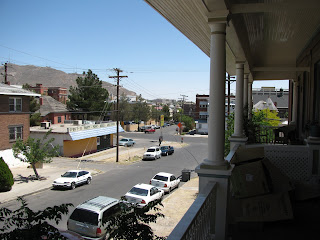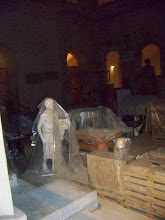Kafka has his own social life.
He’ll sit at the door to the balcony and stare at us, until one of us lets him out.

We have a wrap-around balcony right above an intersection in Sunset Heights. It has 180 degree view, views of the mountains, rooftops, and on the other side we can see a sea of lights that is Ciudad Juárez.

We are practically underneath the El Paso Star, the city’s postcard identity, a lit up Texas star on the side of the biggest mountain.

Kafka’ll sit on the corner of the balcony looking down on the intersection. Directly across from us is a three-story mansion now converted into many rooms, un-air conditioned apartments where poor people live, mostly older women without families.
He stares off at that house or onto the intersection at people walking by, homeless guys looking for spare change, college students parking in front of our building and running late to class. He doesn’t bark at anyone, he hardly ever barks, but occasionally one of the old women coming out of the old mansion will for some reason cause him to tense up, and he’ll bark at her as she slowly crosses the street toward our building.
We don’t know his criteria for barking at someone, but he must have his reasons. A cholo walking by with a bulldog in a spike collar, or two homeless men following a student asking him for money, will not capture Kafka’s attention, but if one of the old ladies comes out of the Escher house, he barks like crazy. Maybe he’s communicating to them, or sensing their energy.

We call it the Escher house because it’s an optical illusion, a strange loop. It has been cut up by the owner into so many different parts, with so many doors and walkways and staircases leading this way and that, going up and down that it seems illogical. Through windows and doors we can glimpse inside and see the old ladies walking downstairs and upstairs and past windows, and before we know it two or more of them walk out of the same door out of the side of the house or the front of the house or both, or the one we see walking up the stairs ends up in the street, while the one walking down the stairs ends up somewhere inside the house. That’s not the only thing strange about it. As I said, there must be about 22 people living there, and during the day you see them go in and out, up and down the stairs, and you might even see one of them standing in his window looking out at the grey sheet of Ciudad Juarez, but at night, all the lights in the Escher house are out.
It stands pitch black on a hill on the corner, as if no one lived there. No one seems to use lights. During the day there is a man who puts two kitchen chairs in the front of the house, under some bushes and sits there, sometimes with an old lady who lives in the building, sometimes alone. This man is huge, like Frankenstein, and he’s bald and walks bent over as if his massive upper body was too heavy to support. He sits out there all day, watching the neighborhood as people come in and out of the house.
Sometimes three Jehovah Witnesses will walk up the cement stairs that lead to the grand entrance of the former mansion, and they go in.
 They must go to all the numbered doors inside the house, and they might come back out an hour later.
They must go to all the numbered doors inside the house, and they might come back out an hour later. I can imagine, when it was a single house, that it must have been beautiful. A rich family must have lived there.

Maybe there used to be a beautiful foyer lined by art.
Kakfa can stay out on the balcony for hours watching the house. Sasha and I could be lying in bed watching a movie, and we’ll try to get Kafka to come joins us, but sometimes he doesn’t feel like it. He wants to be alone. Not all the time, sometimes all he wants is to play or to cuddle with us, but sometimes he prefers to be alone.
This makes sense if you consider two things.
One, we create dogs in our own image. We often hear people comment on how much dogs look like their owners.
Here's an exaggerated image I found on the internet:

I remember having lunch outdoors at the World Café in Venice, California. Sitting a few tables away from us was the famous baseball player/heartthrob Jose Conseco. He wore a silky sweat suit and gold jewelry, and like us he was sitting at the rail, so he could have his dog on a leash on the sidewalk, like I had Felix, my old dog, on his leash. The waiters at that café are very nice to dogs, often bringing them bowls of water, but they simply gushed over Conseco’s dog.
Felix was part German Sheppard and part black lab, a loyal and smart dog, but not flashy.

Conseco’s dog was some exotic breed I had never seen in real life, with such thin and shiny hair it looked like an expensive fur coat.
I don’t remember the breed, all I remember is that the dog had tall legs like a show dog. People passed by and stopped at his dog, who was sitting like royalty next to the table. They asked if they could pet him and Conseco nodded yes. He was eating lunch with his kids.
After having doted so long on the Conseco dog, some people would pass by Felix, and very few of them stopped to pet him, and no one took his picture.
After lunch Conseco stood up like a movie god, tall, built, gleaming with silk and gold.

He and his dog walked down the Venice boardwalk, a sea of people moving out of his way so they could pass, and he was trailed by his kids. People took pictures. Later that day we saw him get into his white Cadillac Escalade, gold plated bumpers and rims, and people took pictures of him driving out of the parking lot. He seemed to enjoy the attention.
Dogs look like their owners for obvious reasons. Owners choose dogs in their own image. When they choose a dog, they choose what they see or want to see about themselves, or what they refuse to acknowledge about themselves.
The other reason dogs look like their owners is their personality. A dog’s individual personality has very little to do with the dog, that is, the dog’s biological system. Personality comes from species then breed. Almost all other personality traits that are individual to the dog come from the owner. If the owner is always nervous, afraid of everything, the dog will hide behind furniture when he hears lighting. If the owner is mean, hates people, hates his neighbors, the dog will bark meanly when anyone approaches. If the owner is always depressed, the dog will be morose. We create dogs, unconsciously or not, in our own image.
I once met a dog who refused to receive affection from anyone but his owner. If you tried to touch him, he would bite you, but he loved being held by his owner, and when she was sitting down, the dog had to be in her lap.
In the mornings I’m in my workspace, doors closed, writing.
Kafka has no one to play with. He might come into my office holding his toy lobster in his mouth ready to play, but he’ll see me working, so he’ll sit there on the carpet.
He gets bored pretty quickly, and he lets out long sighs so that we know it.

Sometimes he stands at the door to the balcony until one of us lets him out, and he’ll go out there alone and stare at the intersection. He barks at the old women coming out of the Escher house, he watches the beeping garbage trucks lift dumpsters with their massive metal claws and pour all that smelly garbage into the back of their tucks. When he’s done being alone, and when we’re done with our need for solitude, he’ll run into the house with his lobster in his mouth ready to play.
Like I said, he has own social life, and sometimes he’ll play for hours with our neighbor, and sometimes Kafka will stay the night with him.
Sometimes Kafka hangs out with his tio.
My neighbor is Ben. He is a novelist and a poet, one of the most well-known writers in El Paso or from El Paso. He has won so many awards it’s hard to keep track, the American Book Award, Landan Foundation. He publishes on an average two books a year. When I was a young Chicano writer starting out in the MFA program at the University of Oregon, the poet Garret Hongo introduced us to his work, and I admired it. He was one of the reasons I thought El Paso might be a good place for me, because of the way he wrote about it.
We live in a renovated two story building, which really must have been something when it was new but which became a slum. It used to be a crack house, and it was in such bad shape the city closed it down, declared it a fire hazard. Then our landlord bought it and did what is unusual for El Paso, spent over a year getting it into great shape, and now it’s beautiful. We have the entire top floor, Ben on one side and Kafka and me on the other. People sometimes ask what it’s like living next to a famous writer, El Paso’s favorite man of letters, and I tell them I don’t know, ask my neighbor.
Really, I tell them it’s like a sitcom called The Writer’s Block.
(End Part One)

